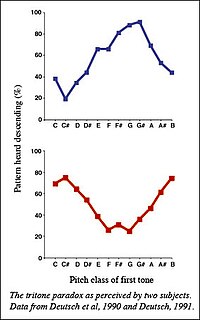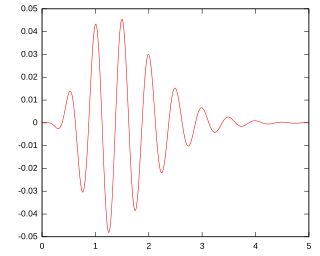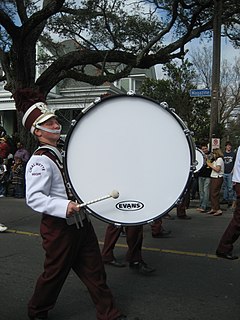
Acoustics is a branch of physics that deals with the study of mechanical waves in gases, liquids, and solids including topics such as vibration, sound, ultrasound and infrasound. A scientist who works in the field of acoustics is an acoustician while someone working in the field of acoustics technology may be called an acoustical engineer. The application of acoustics is present in almost all aspects of modern society with the most obvious being the audio and noise control industries.

The mel scale, named by Stevens, Volkmann, and Newman in 1937, is a perceptual scale of pitches judged by listeners to be equal in distance from one another. The reference point between this scale and normal frequency measurement is defined by assigning a perceptual pitch of 1000 mels to a 1000 Hz tone, 40 dB above the listener's threshold. Above about 500 Hz, increasingly large intervals are judged by listeners to produce equal pitch increments. As a result, four octaves on the hertz scale above 500 Hz are judged to comprise about two octaves on the mel scale. The name mel comes from the word melody to indicate that the scale is based on pitch comparisons.

Pitch is a perceptual property of sounds that allows their ordering on a frequency-related scale, or more commonly, pitch is the quality that makes it possible to judge sounds as "higher" and "lower" in the sense associated with musical melodies. Pitch can be determined only in sounds that have a frequency that is clear and stable enough to distinguish from noise. Pitch is a major auditory attribute of musical tones, along with duration, loudness, and timbre.
Auditory illusions are false perceptions of a real sound or outside stimulus. These false perceptions are the equivalent of an optical illusion: the listener hears either sounds which are not present in the stimulus, or sounds that should not be possible given the circumstance on how they were created.
The octave illusion is an auditory illusion discovered by Diana Deutsch in 1973. It is produced when two tones that are an octave apart are repeatedly played in alternation ("high-low-high-low") through stereo headphones. The same sequence is played to both ears simultaneously; however when the right ear receives the high tone, the left ear receives the low tone, and conversely. Instead of hearing two alternating pitches, most subjects instead hear a single tone that alternates between ears while at the same time its pitch alternates between high and low.

The tritone paradox is an auditory illusion in which a sequentially played pair of Shepard tones separated by an interval of a tritone, or half octave, is heard as ascending by some people and as descending by others. Different populations tend to favor one of a limited set of different spots around the chromatic circle as central to the set of "higher" tones. Roger Shepard in 1963 had argued that such tone pairs would be heard ambiguously as either ascending or descending. However, psychology of music researcher Diana Deutsch in 1986 discovered that when the judgments of individual listeners were considered separately, their judgments depended on the positions of the tones along the chromatic circle. For example, one listener would hear the tone pair C–F♯ as ascending and the tone pair G–C♯ as descending. Yet another listener would hear the tone pair C–F♯ as descending and the tone pair G–C♯ as ascending. Furthermore, the way these tone pairs were perceived varied depending on the listener's language or dialect.

The illusory continuity of tones is the auditory illusion caused when a tone is interrupted for a short time, during which a narrow band of noise is played. The noise has to be of a sufficiently high level to effectively mask the gap, unless it is a gap transfer illusion. Whether the tone is of constant, rising or decreasing pitch, the ear perceives the tone as continuous if the discontinuity is masked by noise. Because the human ear is very sensitive to sudden changes, however, it is necessary for the success of the illusion that the amplitude of the tone in the region of the discontinuity not decrease or increase too abruptly. While the inner mechanisms of this illusion is not well understood, there is evidence that supports activation of primarily the auditory cortex is present.
Acoustic phonetics is a subfield of phonetics, which deals with acoustic aspects of speech sounds. Acoustic phonetics investigates time domain features such as the mean squared amplitude of a waveform, its duration, its fundamental frequency, or frequency domain features such as the frequency spectrum, or even combined spectrotemporal features and the relationship of these properties to other branches of phonetics, and to abstract linguistic concepts such as phonemes, phrases, or utterances.

Volley theory states that groups of neurons of the auditory system respond to a sound by firing action potentials slightly out of phase with one another so that when combined, a greater frequency of sound can be encoded and sent to the brain to be analyzed. The theory was proposed by Ernest Wever and Charles Bray in 1930 as a supplement to the frequency theory of hearing. It was later discovered that this only occurs in response to sounds that are about 500 Hz to 5000 Hz.
Computational auditory scene analysis (CASA) is the study of auditory scene analysis by computational means. In essence, CASA systems are "machine listening" systems that aim to separate mixtures of sound sources in the same way that human listeners do. CASA differs from the field of blind signal separation in that it is based on the mechanisms of the human auditory system, and thus uses no more than two microphone recordings of an acoustic environment. It is related to the cocktail party problem.

A gammatone filter is a linear filter described by an impulse response that is the product of a gamma distribution and sinusoidal tone. It is a widely used model of auditory filters in the auditory system.
The ASA Silver Medal is an award presented by the Acoustical Society of America to individuals, without age limitation, for contributions to the advancement of science, engineering, or human welfare through the application of acoustic principles or through research accomplishments in acoustics. The medal is awarded in a number of categories depending on the technical committee responsible for making the nomination.

In physics, sound is a vibration that propagates as an acoustic wave, through a transmission medium such as a gas, liquid or solid.
Barbara Shinn-Cunningham is an American bioengineer and neuroscientist. She is director of the Carnegie Mellon University Neuroscience Institute, the George A. and Helen Dunham Cowan Professor of Auditory Neuroscience, and Professor of Psychology, Electrical and Computer Engineering, and Biomedical Engineering.

Karalyn Eve Patterson, is a British psychologist in Department of Clinical Neurosciences, University of Cambridge and MRC Cognition and Brain Sciences Unit. She is a specialist in cognitive neuropsychologyand an Emeritus Fellow of Darwin College, Cambridge.

Lloyd Alexander Jeffress was an acoustical scientist, a professor of Experimental Psychology at the University of Texas at Austin, a developer of mine-hunting models for the US Navy during World War II and after, and the man Nobel Laureate Linus Pauling credited with getting him interested in chemistry.
Temporal envelope (ENV) and temporal fine structure (TFS) are changes in the amplitude and frequency of sound perceived by humans over time. These temporal changes are responsible for several aspects of auditory perception, including loudness, pitch and timbre perception and spatial hearing.

Brian C.J. Moore FmedSci, FRS is an Emeritus Professor of Auditory Perception in the University of Cambridge and an Emeritus Fellow of Wolfson College, Cambridge. His research focuses on psychoacoustics, audiology, and the development and assessment of hearing aids.
Auditory science or hearing science is a field of research and education concerning the perception of sounds by humans, animals, or machines. It is a heavily interdisciplinary field at the crossroad between acoustics, neuroscience, and psychology. It is often related to one or many of these other fields: psychophysics, psychoacoustics, audiology, physiology, otorhinolaryngology, speech science, automatic speech recognition, music psychology, linguistics, and psycholinguistics.
Christian Lorenzi is Professor of Experimental Psychology at École Normale Supérieure in Paris, France, where he has been Director of the Department of Cognitive Studies and Director of Scientific Studies until. Lorenzi works on auditory perception.













